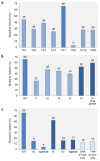In Vitro Selection of an ATP-Binding TNA Aptamer
- PMID: 32933142
- PMCID: PMC7570665
- DOI: 10.3390/molecules25184194
In Vitro Selection of an ATP-Binding TNA Aptamer
Abstract
Recent advances in polymerase engineering have made it possible to isolate aptamers from libraries of synthetic genetic polymers (XNAs) with backbone structures that are distinct from those found in nature. However, nearly all of the XNA aptamers produced thus far have been generated against protein targets, raising significant questions about the ability of XNA aptamers to recognize small molecule targets. Here, we report the evolution of an ATP-binding aptamer composed entirely of α-L-threose nucleic acid (TNA). A chemically synthesized version of the best aptamer sequence shows high affinity to ATP and strong specificity against other naturally occurring ribonucleotide triphosphates. Unlike its DNA and RNA counterparts that are susceptible to nuclease digestion, the ATP-binding TNA aptamer exhibits high biological stability against hydrolytic enzymes that rapidly degrade DNA and RNA. Based on these findings, we suggest that TNA aptamers could find widespread use as molecular recognition elements in diagnostic and therapeutic applications that require high biological stability.
Keywords: TNA; aptamer; biological stability.
Conflict of interest statement
We have no competing interests.
Figures





Similar articles
-
In vitro selection of an XNA aptamer capable of small-molecule recognition.Nucleic Acids Res. 2018 Sep 19;46(16):8057-8068. doi: 10.1093/nar/gky667. Nucleic Acids Res. 2018. PMID: 30085205 Free PMC article.
-
Redesigning the Genetic Polymers of Life.Acc Chem Res. 2021 Feb 16;54(4):1056-1065. doi: 10.1021/acs.accounts.0c00886. Epub 2021 Feb 3. Acc Chem Res. 2021. PMID: 33533593
-
Reverse Transcription of Threose Nucleic Acid by a Naturally Occurring DNA Polymerase.Chembiochem. 2016 Oct 4;17(19):1804-1808. doi: 10.1002/cbic.201600338. Epub 2016 Aug 4. Chembiochem. 2016. PMID: 27383648
-
In vitro selection of BNA (LNA) aptamers.Artif DNA PNA XNA. 2013 Apr-Jun;4(2):39-48. doi: 10.4161/adna.25786. Artif DNA PNA XNA. 2013. PMID: 24044051 Free PMC article. Review.
-
Versatility of threose nucleic acids: synthesis, properties, and applications in chemical biology and biomedical advancements.Chem Commun (Camb). 2024 Oct 15;60(83):11864-11889. doi: 10.1039/d4cc04443f. Chem Commun (Camb). 2024. PMID: 39318271 Review.
Cited by
-
A system for in vitro selection of fully 2'-modified RNA aptamers.Org Biomol Chem. 2025 Mar 5;23(10):2375-2379. doi: 10.1039/d4ob01505c. Org Biomol Chem. 2025. PMID: 39912583
-
Biologically stable threose nucleic acid-based probes for real-time microRNA detection and imaging in living cells.Mol Ther Nucleic Acids. 2022 Jan 3;27:787-796. doi: 10.1016/j.omtn.2021.12.040. eCollection 2022 Mar 8. Mol Ther Nucleic Acids. 2022. PMID: 35116190 Free PMC article.
-
The Expanded Central Dogma: Genome Resynthesis, Orthogonal Biosystems, Synthetic Genetics.Annu Rev Biophys. 2023 May 9;52:413-432. doi: 10.1146/annurev-biophys-111622-091203. Annu Rev Biophys. 2023. PMID: 37159296 Free PMC article. Review.
-
Nucleic Acids and Their Analogues for Biomedical Applications.Biosensors (Basel). 2022 Feb 4;12(2):93. doi: 10.3390/bios12020093. Biosensors (Basel). 2022. PMID: 35200353 Free PMC article. Review.
-
An RNA-cleaving threose nucleic acid enzyme capable of single point mutation discrimination.Nat Chem. 2022 Mar;14(3):350-359. doi: 10.1038/s41557-021-00847-3. Epub 2021 Dec 16. Nat Chem. 2022. PMID: 34916596
References
-
- Dunn M.R., Jimenez R.M., Chaput J.C. Analysis of aptamer discovery and technology. Nat. Rev. Chem. 2017;1:0076. doi: 10.1038/s41570-017-0076. - DOI
MeSH terms
Substances
Grants and funding
LinkOut - more resources
Full Text Sources
Other Literature Sources

